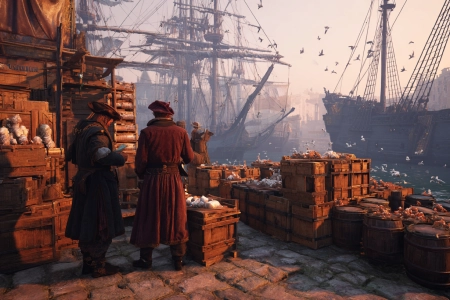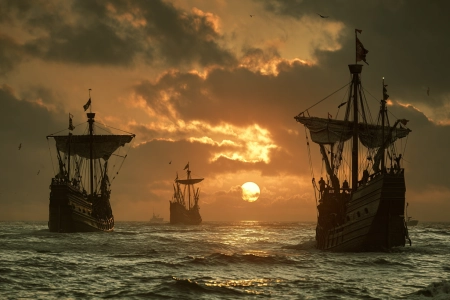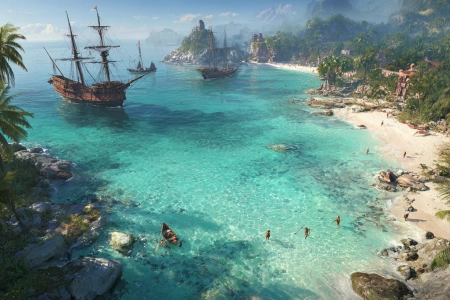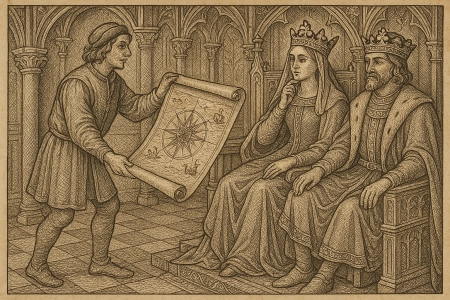Christopher Columbus: The 1492 Voyage to the Americas
Columbus: voyage to the Americas and the Columbian Exchange's global impact.
Reading time: ~9-11 min
Introduction: Why 1492 Still Matters
In August 1492, Christopher Columbus sailed from Palos de la Frontera under the auspices of the Crown of Castile, seeking a westward route to Asia. Instead, his first voyage to the Americas forged a repeatable Atlantic crossing, accelerated the Columbian Exchange, and initiated enduring connections—and conflicts—between the Old and New Worlds. This article follows the 1492 voyage—the route, the ships (Niña, Pinta, Santa María), the leverage of trade winds, the first landfall at Guanahani/San Salvador, and Taíno first contact—while addressing seasonal questions around Columbus Day vs. Indigenous Peoples' Day, myths and facts, and the voyage's legacy.

The World Before 1492: Context and Motives
By the late fifteenth century, Portuguese mariners were probing down the African coast toward the Indian Ocean while the Ottoman Empire dominated eastern Mediterranean trade. Spain, newly consolidated under Ferdinand and Isabella, sought competitive access to Asian markets. Columbus proposed a westward leap across the “Ocean Sea.” He was not the first European to reach the western Atlantic—Norse voyages to Vinland are well attested—but he was the first to secure sustained, state-backed crossings that would bind the Atlantic world together. A maturing print culture ensured the voyage's news spread rapidly, magnifying its impact.
Preparing the Expedition: Money, People, and Ships
Who funded Columbus? The Crown of Castile provided primary backing after prolonged negotiations, aided by figures such as Luis de Santángel. Crucially, the Pinzón brothers—Martín Alonso and Vicente Yáñez—contributed ships, men, and the maritime networks of Huelva.
What ships sailed in 1492? The flagship Santa María (a larger nao) emphasized cargo and command capability, while the Niña and Pinta (agile caravels) offered speed and maneuverability. The mixed fleet allowed reconnaissance, coastal pilotage, and open-ocean endurance.
Skills on board. Iberian sailors brought expertise in dead reckoning, coastal piloting, and practical astronomy (e.g., the pole star for latitude). Instruments like the astrolabe or quadrant offered rough readings when conditions permitted, but mastery of winds and currents—rather than precision tools—was decisive.
From Palos to the Canaries: Staging the Westward Leap
The fleet departed Palos on 3 August 1492, making first for the Canary Islands. Repairs and rigging changes were routine. More importantly, the Canaries served as the springboard to catch the reliable Northeast Trade Winds. Columbus intended to ride those winds west across mid-latitudes, then return along a higher-latitude arc using the westerlies and the Gulf Stream—a pattern later called the volta do mar (“turn of the sea”).

Crossing the Ocean Sea: Winds, Worries, and Watchkeeping
How long did the first voyage take? From the Canaries to landfall in the Bahamas, the westward crossing lasted roughly five weeks. Watch changes, log readings, and speed estimates drove dead reckoning. Columbus likely recorded two distances—one public to sustain morale and one private—while noting flocks of birds, floating branches, and Sargasso weed as hopeful signs of land. The Pinta briefly broke away and later rejoined near Hispaniola.
Navigation and instruments. Mariners gauged direction with the compass, speed with a log line and sandglass, and latitude from the pole star's height when visible. Quadrants and astrolabes were available but unreliable in heavy seas; the voyage succeeded less through instruments than through the Iberians' growing command of the Atlantic wind systems.
“Where Did Columbus Land First?”: The Bahamas, October 1492
What day did Columbus land? Landfall occurred on 12 October 1492 (modern Gregorian date). Columbus called the island Guanahani, renaming it San Salvador. The exact island remains debated—San Salvador Island (Watlings) is the traditional candidate, though other Bahamian sites have been proposed.
Taíno first contact. Columbus encountered Taíno islanders, describing exchanges of gifts and curiosity while also noting opportunities for conversion and labor—early clues to the asymmetrical power dynamics that would define the encounter. Within weeks the fleet explored parts of the Bahamas and Cuba, impressions Columbus misread as the fringes of Asia.
Toward Hispaniola: Shipwreck and La Navidad
By late 1492 the expedition reached Hispaniola (modern Haiti and the Dominican Republic). On the night of 24-25 December, the Santa María ran aground and broke apart. With local assistance, timber from the wreck became the stockade of La Navidad, the first European outpost in the Caribbean.
What happened at La Navidad (1492-93)? Columbus left a small garrison and sailed for Spain on the Niña. When he returned on the second voyage, La Navidad had been destroyed and its men killed—an early indicator that the encounter had already turned violent and extractive.

The Homeward Leg: Azores, Lisbon, and Palos
The return tested the Atlantic gyre strategy. A storm split the Niña and Pinta;
Columbus was blown to the Azores and then to Lisbon before
reaching Palos on 15 March 1493. The loop northwards into the
westerlies—then east to Iberia—became the classic wind-wheel
of Atlantic navigation for
centuries.
Did Columbus “Discover” America?
The phrase discovery of America
is historically loaded. The Americas were
home to millions, with sophisticated societies ranging from the Taíno to the
Aztec and Inca. Norse explorers reached North
America centuries earlier. Still, 1492 marked the beginning of continuous, state-backed
transatlantic crossings and the integration of the Atlantic world.
A more neutral framing is the Columbian encounter
or first
sustained contact
between Old World and New World.
Consequences: The Columbian Exchange
Columbus's voyage accelerated the Columbian Exchange—the hemispheric transfer of plants, animals, peoples, microbes, and ideas. Maize, potatoes, tomatoes, cacao, and tobacco moved to Eurasia and Africa; wheat, sugarcane, horses, cattle, and pigs came to the Americas. Disease—smallpox, measles, influenza—proved catastrophic for Indigenous populations. Slavery and coercive labor systems expanded under later colonial regimes. These transformations were not inevitable, but 1492 was a key hinge.
Myths and Facts: Popular Questions, Clear Answers
Where did Columbus land first?
On 12 October 1492 at Guanahani in the Bahamas, which he renamed San Salvador. The precise island is debated, with San Salvador Island the leading candidate.
What route did Columbus take in 1492?
From Palos to the Canary Islands, then west on the Northeast Trade Winds across the Atlantic to the Bahamas and Hispaniola. The return arced north into the westerlies, then east via the Azores to Lisbon/Palos, aided by the Gulf Stream.
How long did the first voyage take?
About ten months end-to-end (August 3, 1492-March 15, 1493), with roughly five weeks from the Canaries to the first landfall.
Who funded Columbus (Ferdinand and Isabella)?
Primarily the Crown of Castile (Ferdinand and Isabella), with crucial advocacy by Luis de Santángel and tangible support from the Pinzón brothers.

What ships did Columbus use (Niña, Pinta, Santa María)?
The Santa María (a nao) served as flagship and wrecked off Hispaniola; the Niña and Pinta were caravels—smaller, faster, and vital for exploration and the crossing.
What happened at La Navidad (1492)?
A small outpost built from Santa María timbers; by 1493 it had been destroyed and its men killed, signaling early conflict and instability.
Columbus Day vs. Indigenous Peoples' Day: Memory and Debate
Each October, debates intensify over celebration versus commemoration. Some communities retain Columbus Day; others mark Indigenous Peoples' Day, centering Indigenous experiences, resilience, and the costs of colonization. Both the achievements in navigation and the harms of conquest belong in the historical record. A balanced approach treats 1492 as both a turning point in global connectivity and the beginning of profound upheaval for the peoples of the Americas.
Ships, Skills, and the Atlantic “Wind-Wheel”
Caravels and the Flagship
The caravel—light, agile, with adjustable rigs—permitted coasting and blue-water sailing. The nao offered capacity but less nimbleness. The mixed fleet gave Columbus flexibility: reconnaissance in the caravels, command and storage in the nao.
Dead Reckoning and Imperfect Instruments
Without precise longitude, sailors estimated position by course, speed, and time. Quadrants and astrolabes offered rough latitudes in calm conditions; cloud cover and ship motion reduced accuracy. Seamanship and wind sense mattered more than any single instrument.
Riding the Trades; Returning on the Westerlies
The breakthrough wasn't a new tool but a systematic route: ride the Northeast Trades westward; return by curving north into the westerlies and toward the Azores, then down the Portuguese coast on the Gulf Stream. This wind-wheel made a two-way Atlantic.
Sources, Journals, and What We Can—and Cannot—Know
Our knowledge of the voyage comes from Columbus's diario (preserved in later copies and summaries), the 1493 letter that circulated widely in print, and accounts by crew and later chroniclers. Scholars compare versions, note contradictions, and cross-check dates with astronomical and navigational data. Some details—the exact landfall island—remain contested; others—the Santa María's wreck, La Navidad's fate—are well attested.
Consequences and Legacies: Beyond the First Voyage
The Treaty of Tordesillas (1494) divided spheres of influence between Spain and Portugal, shaping claims across the Atlantic. Subsequent voyages (1493-1504) expanded Spanish footholds, while other powers soon followed. The Columbian Exchange remade diets, economies, ecologies, and populations worldwide, with enormous human costs for Indigenous peoples through disease, dispossession, and forced labor. Understanding 1492 today means balancing navigational achievement with ethical reckoning—teaching both the techniques of oceanic exploration and the voices of the encountered.
Quick FAQ
Did Columbus really discover America?
Where did he land first?
What route did he take?
How long did the crossing take?
What ships sailed in 1492?
Who funded the voyage?
What was La Navidad?
Conclusion: How to Read 1492 Now
The 1492 voyage to the Americas was a turning point in the early modern Atlantic. Columbus's seamanship, the Pinzóns' local expertise, and Iberian command of the trade winds produced a repeatable crossing. Yet the moment of first contact also opened an era of conquest, coerced labor, and demographic catastrophe. In classrooms and public history, the best approach is not to choose between celebration or condemnation, but to study the evidence, confront the myths, include Indigenous perspectives, and recognize how 1492 reshaped two worlds.
Sources & References
- Christopher Columbus, Journal of the First Voyage (scholarly editions/translations).
- Felipe Fernández-Armesto, Columbus (Oxford University Press).
- Samuel Eliot Morison, Admiral of the Ocean Sea (Little, Brown).
- Laurence Bergreen, Columbus: The Four Voyages (Viking).
- Essays on the Columbian Exchange and Atlantic history (university presses, museum resources such as Smithsonian NMAI).